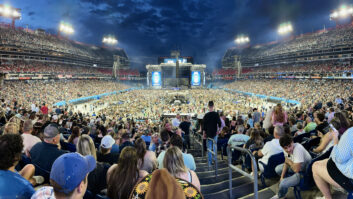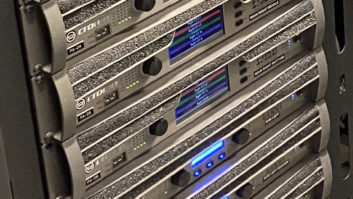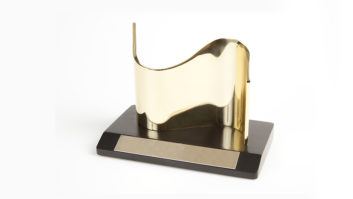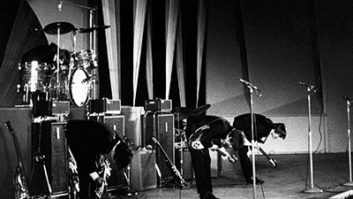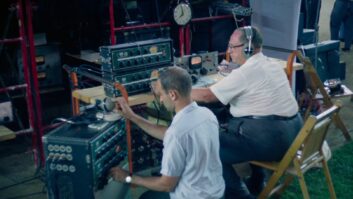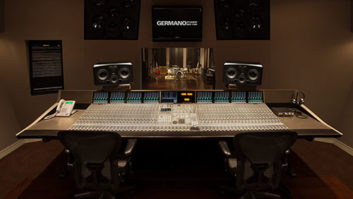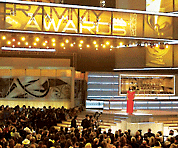

Most awards shows just need to look good. But nobody really notices the sound, unless, of course, it completely cuts out during some celebrity acceptance speech. Even most music awards shows are more about outfits and bling than they are about actual musical performances. The Grammy® Awards telecast is different. It’s the premier annual showcase for the recording industry, and those involved take sound very seriously.
They also never play it safe. It’s broadcast in mono, stereo, Dolby Pro Logic II and discrete 5.1 Dolby Digital to a total of, in 2005, 18.8 million viewers. Held at Los Angeles’ Staples Center, the 47th Annual Grammy Awards featured three-plus stages, 20 performances by 17 artists and an opening sequence that used approximately 120 channels of audio for five acts performing across three stages. Dealing with all of this took around 450 microphones, nine mixers at eight digital mixing consoles and more than 60 audio technicians, along with input from some of the recording industry’s finest. For more information on the house sound, visit www.mixonline.com.
STEREO PLUS SURROUND
The 2003 Grammys was the first awards show to be produced in high-def with 5.1; this year, it was about fine-tuning the process. Main 5.1 music mixing and stereo music mixing was a team effort by John Harris and Jay Vicari in Effanel’s L7 truck using a Neve Capricorn console augmented by a Yamaha DM2000. Each act got 60 minutes of rehearsal (not including dress rehearsal) with two to three passes of each performance.
“We record the rehearsals, listening in stereo, while the cameras are rolling,” Harris explains. “All of our compression and EQ are on the monitor side. When the cameras are done, we’ll play back tracks, establish the stereo mix and flip on the surround. The Capricorn runs both simultaneously very nicely. The way you assign follows pans, et cetera, so there isn’t a big sonic jump between the formats.”
The stereo mix is also the one that’s monitored during the show. “Our surrounds are built so that any moves we make in stereo will map in 5.1,” adds Vicari. “We’re constantly monitoring back and forth to make sure that both mixes are compatible.”
Only onboard Capricorn EQ was used, notes Vicari, who prefers to avoid the phase coherency issues that can result from multiple inserts of analog outboard devices. Other outboard was minimal and comprised Empirical Labs Distressors on vocals, TC Electronic System 6000s and Lexicon 960 reverbs.
“The opening number was, obviously, one of the biggest challenges of this year’s show,” says Harris, “with 120 tracks of recording and mixing — and the crossfading between them — going on basically at the same time. Every input we had was used.
“The cooperation that goes into this kind of audio production is really unparalleled,” he continues, “from the A2s onstage to the crew from Dolby, who provide us with hardware and tune all the listening environments so we’re all on the same page. There’s no room for error; if one department were to fail, the whole thing would go down.”
AUDIENCE 6.0
New to the 2005 show was the addition of a separate mix station to record audience reaction. Aiming to enhance the broadcast experience by capturing the excitement of the live audience, mixer Klaus Landsberg used a Yamaha DM2000 console and a combination of 32 Neumann, Sennheiser and AKG mics, along with a 6-channel Holophone microphone situated over the front-of-house console area to create six discrete audience stems that were then sent to the overall 5.1 mix.
“The audience is the one thing that can’t be rehearsed,” explains Hank Neuberger of the NARAS Producers & Engineers Wing advisory council. “Typically during the show, production mixer Ed Greene doesn’t have time to balance the audience mics so as to create a great atmosphere. It doesn’t help that, traditionally, our ‘industry’ crowd doesn’t clap very much. That makes it difficult to convey the excitement of the incredible lineup of talent.”
A total of 22 Neumann KM84 mics, which Landsberg calls his favorite audience mic, provided the bulk of the coverage. “They’re a very rich-sounding mic, and they get a lot of dynamics without overloading on the front end,” he explains. Additionally, four Sennheiser 416s, four AKG C547s across the front of the stage and two TLM 100s in the rear of the hall were used, along with 17 Aphex 1788 8-channel mic preamps: five in Landsberg’s control room and 12, remote-controlled via MADI, onstage. A TC Electronic Mastering 6000 was used for multiband compression on the stems to “fatten them up and give a little control over the balance,” while Cedar DNS1000 noise suppressors provided help with “shaping” the room.
MIXING FOR BROADCAST
In the All-Mobile Video truck, dubbed Resolution I, Greene — who also mixes the Oscars, the Emmys and the Macy’s Thanksgiving Day Parade, among countless other big shows — served as broadcast mix master for “something like the 25th or 30th time,” with Phil Ramone onboard as advisor. A Sony Oxford console was his hub for combining approximately 80 inputs, comprising the Effanel truck’s music feeds and the production elements: podium, lavalier and announce mics; voice-overs; video and audio playback; and an audience feed from Landsberg that Greene controlled by a foot-operated volume pedal.
“Everything you hear on standard TV comes through here,” Greene says. “I also feed a dialog bus to the 5.1 truck, and I feed the playback elements to everybody: the house, monitors, air and 5.1. As a general rule, I use minimal processing. When you’re dealing with most digital desks, it’s generally wise to use the built-in EQs, compressors, et cetera, to allow for ‘scenes’ and general reset-ability.
“I did use an external dbx compressor in a dialog chain because there was no internal compressor available at that crosspoint,” he continues. “And in the final output, there was a TC Finalizer — with its CD Master program set for gentle curve shaping — and an Aphex Compellor. For me, the Compellor still provides the most transparent management of program processing. It keeps me out of trouble with satellites and gives the best impression of natural dynamics.”
Greene listens “90 percent of the time” on a mono (Genelec or Meyer HD1) speaker, even though, in addition to the stereo broadcast feed, he’s also creating a Dolby Pro Logic-encoded 5.1 feed for the standard-definition surround broadcast. “I set it all up in stereo,” he says. “I also feed the surround mix left and right with things spread out. I take the music and wrap it around a little bit, and I use a Spatializer on the dialog so it’s more homogeneous and not just in the center. But I’m very sensitive to the mono listener.”
THE DISCRETE 5.1 MIX
With something like 620 lines of audio bouncing from stage to FOH, monitors and the “truck farm,” the routing is a story unto itself. Also in the loop was mixer Paul Sandweiss, working in the Effanel OSR truck on two Yamaha DM2000 consoles, where he was in charge of the discrete 5.1 surround mix heard by those watching in high def.
“When they asked me to do this,” says Sandweiss, who owns his own busy company, Sound Design Corp., “I thought it would be the most fun job on the show. I got the 5.1 music feed from Jay and John, and from Ed a stereo submix of all the production elements that I blew out to 5.1. I also had six stereo pairs of audience from Klaus: front, mid and deep perspectives, along with an up-close camera mic pair. Those are delicate to manage because you don’t want the room sound to be constantly changing. The audience tracks are so important, but you don’t have any idea of how it will sound until the audience arrives.”
THE FINAL LINKS
Final uplink compression, the last processing before the mixes are Dolby E-encoded, was supplied by a TC Electronic DBMax for the stereo/Dolby Pro Logic II mix and a TC DB-8 for the 5.1 mixes. A combination of experts from Dolby and CBS worked with the Grammy team to adjust encoding and transmission of the Dolby E, and each truck was fitted with Dolby boxes, allowing monitoring of the feeds at different points in the transmission chain.
As explained by Murray Allen, NARAS audio consultant for the Grammys, the Dolby E transmission is shipped directly to CBS N.Y. For the first time this year, the metadata — which contains compression words, dialog level, downmix coefficients and parameters and mix information — was embedded in the Dolby E. In New York, the audio signal is converted to PCM digital, commercials and a five-second delay are added, and sync is checked. The metadata is removed and follows on a data cable. Ultimately, the 5.1 and stereo audio signal are re-encoded to Dolby E, with the metadata once more embedded. The Dolby E-encoded signal (embedded with picture) is shipped out to two different satellite uplink stations. Finally, local stations use the metadata information to convert the Dolby E to Dolby AC3 required for broadcast.
THE OVERVIEW
According to calculations by overall Grammy Awards audio coordinator Michael Abbott, between front of house, monitors and broadcast, including rehearsal, dress rehearsal, the telecast and all the setup and teardowns, the 2005 show encompassed 3,000-plus patches during the course of a week. “This is the mother of all audio shows,” he says. “I don’t think there’s another production comparable to this event in terms of connectivity and complexity. The more people you have mixing a show, the more disjointed the sound design can become. Our goal is to have a singular, cohesive sound. It’s a huge collaborative effort, and a lot of enormously talented people pull together to make it happen.”

What goes on audio-wise in Don Worsham’s “And the Winner Is” room? Click here to find out.
